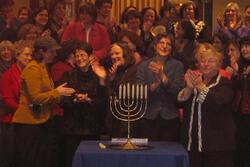Discovering a Feminine Rabbinic Look
In this first piece from our Reimagining ‘Rabbi’ series, rabbinical student Alex Weissman responds to this clip:
"Baruch Adonai Eloheynu melech ha’olam malbish/ Blessed are You Adonai our God, sovereign of the universe, who clothes the naked.” Every morning, these are some of the first words that come out of my mouth. Expressing gratitude for the interconnected, divine chain of nature, labor, and body that makes getting dressed every morning possible has become an important part of my spiritual practice during my time in rabbinical school.
In her video reflecting on how women rabbis have changed the rabbinate for men, Rabbi Jacqueline Koch Ellenson highlights the tension that many rabbis have felt between their personal role (partner, parent, friend, someone with hobbies, etc.) with their professional role (visiting the sick, leading services, attending board meetings, etc.). For some in the rabbinate, the professional role has totally eclipsed the personal one and people are in rabbinic roles 24/7. This lack of boundaries has meant neglecting oneself and one’s relationship with others and ultimately has resulted in rabbis bringing less of themselves to the work. In this model, everyone misses out. As Rabbi Ellenson points out, our existence as human beings is at stake in these questions.
In the video, Rabbi Ellenson silently, but no less subtly, teaches the Torah of being both a human being and a rabbi through her choice of clothes. With her pink and lacy top, her multiple necklaces, and her glossy lipstick, Rabbi Ellenson models how rabbinic authority need not be drab or masculine; this authority can be vibrant and feminine. Women rabbis receive inappropriate comments on their clothes with a frequency and intensity I doubt I will ever experience as a gentleman rabbi. That said, as a queer man months away from rabbinic ordination, I have struggled to realize a fashion that feels at once rabbinic and expressive of the fullness of my humanity.
Recently, some friends of mine convinced me to sign up for one of those online clothes shopping websites where you fill out your preferences and sizes, tell them what you’re looking for, and receive some items selected for you every few months. You then buy what you like and send back what you don’t. In the “about me” box on the website, I let them know that I was queer and interviewing for rabbinic jobs and was looking for some new outfits.
Today, the first box arrived. As I opened the box and looked inside at the neatly folded clothes, I first noticed the colors. Black. White. Black and White. Gray. Black. I was shocked! I read the note from the stylist who selected the items for me, who wrote, “I see that you’re looking for formal interview looks for rabbi positions, so I created a conservative, classic, and monochromatic [look] for you to try.” While I appreciated the thoughtfulness of the note (which included wishing me luck on my interviews!), I couldn’t get over the conservative, monochromatic look. Having checked off nearly every color except “olive” and “taupe” on my preferences, I had hoped for a brighter palette to arrive at my door.
Clearly, the stylist had not met Rabbi Ellenson or the many women rabbis who have modeled a rabbinic fashion that embodies both playful color and authority. In order to live in the fullness of my humanity and my professional role, I need to wear clothes that reflect my queerness, my particular blend of masculinity and femininity ,and still embody rabbinic authority. I am so grateful for the women rabbis and the sprinkling of queer men rabbis in my life who have modeled the diverse ways a rabbi can dress for me. They have taught me again and again the lesson of bringing my full humanity to my rabbinate.
If the morning blessing for clothing the naked is the lowest baseline, during which we are simply giving thanks for having clothes at all, then I imagine our Friday night liturgy, L’cha Dodi, as the ideal. “Livshi bigdei tifarteich ami / Wear the clothes of your splendor, my people.” The possessive suffix for “your” here is in a singular form, hinting that while this line is addressed to an entire people, each of us needs to express our own, personal version of splendor as part of the collective splendor of the Jewish people. It is an invitation for a flamboyant humanity. The suffix “your” is also feminine. I take this as an invitation to celebrate the feminine splendor that is in each of us. While ‘feminine’ looks and feels different in every human, I am grateful for those who have taught me to see my femininity through the lens of splendor and not the lens through which femininity is most often seen in our world: shame or weakness.
To be fully human, we need to not only be clothed, but to be dressed in our splendor. Thank you to Rabbi Ellenson for this Torah.
Love Alex's reflection? Want to stay up to date on our weekly Reimagining 'Rabbi' series? Let us know!







